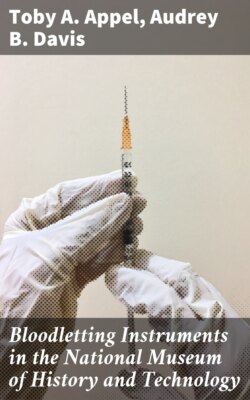Читать книгу Bloodletting Instruments in the National Museum of History and Technology - Audrey B. Davis - Страница 3
На сайте Литреса книга снята с продажи.
PREFACE
ОглавлениеTable of Contents
Among the many catalogs of museum collections, few describe objects related to the practice of medicine. This catalog is the first of a series on the medical sciences collections in the National Museum of History and Technology (NMHT). Bloodletting objects vary from ancient sharp-edged instruments to the spring action and automatic devices of the last few centuries. These instruments were used in a variety of treatments supporting many theories of disease and therefore reflect many varied aspects of the history of medicine. Beginning with an essay sketching the long history of bloodletting, this catalog provides a survey of the various kinds of instruments, both natural and man-made, that have been used throughout the centuries.
It is a pleasure to thank the Smithsonian Research Foundation, the Commonwealth Foundation, and the Houston Endowment for their financial support of this project.
Miss Doris Leckie, who did much of the preliminary research and organized part of the collection that led to a draft of this catalog with special emphasis on the cupping apparatus, receives our highest gratitude. Her public lectures on the topic drew much praise. The usefulness of this catalog is due in no small part to her devoted efforts.
For photographing the Smithsonian objects so well we thank Richard Hofmeister, John Wooten, and Alfred Harrell of the Smithsonian Office of Printing and Photographic Services. For analyzing selected objects and answering our requests promptly we thank Dr. Robert Organ, chief; Barbara Miller, conservation director; and Martha Goodway, metallurgist, of the Conservation Analytical Laboratory.
To those who helped us to solve specific problems we extend appreciation to Dr. Arthur Nunes; Dr. Uta C. Merzbach, curator of mathematics, NMHT (especially for finding the poem by Dr. Snodgrass); and Silvio Bedini, deputy director, NMHT, whose enthusiasm and unmatched ability for studying objects has sustained us throughout the period of preparation.
While it is traditional to add a reminder that various unnamed people contributed to a publication, it is imperative to state here that numerous people are essential to the collection, conservation, preservation, and exhibition of museum objects. Without them no collection would survive and be made available to those who come to study, admire or just enjoy these objects. We hope this catalog brings out some of the joy as well as the difficulties of maintaining a national historical medical collection.
